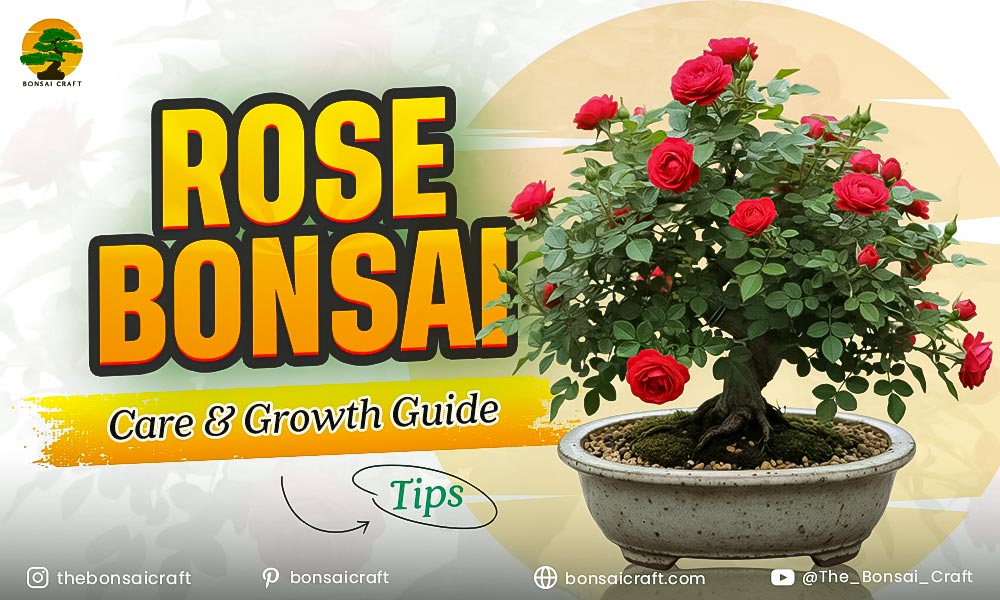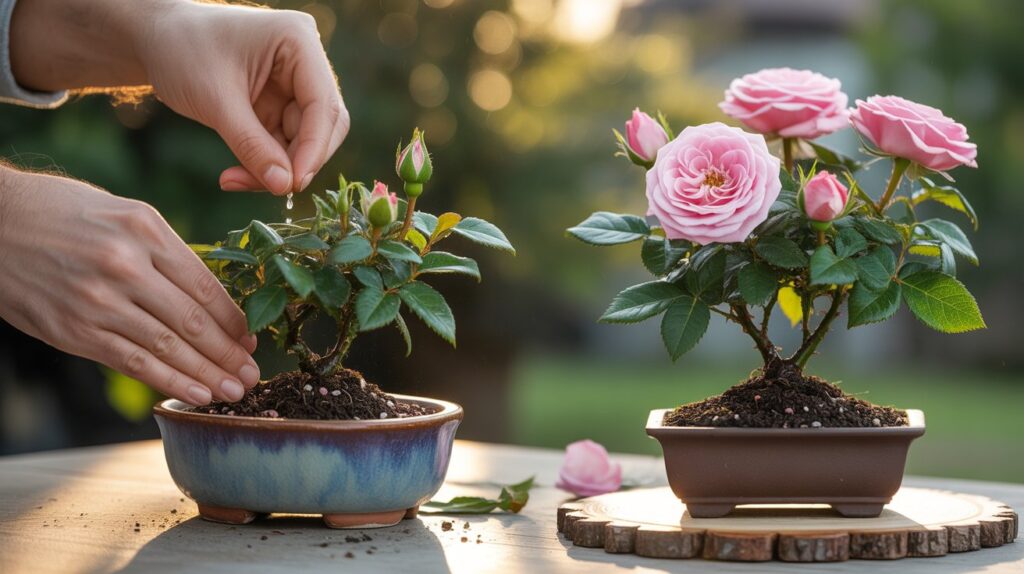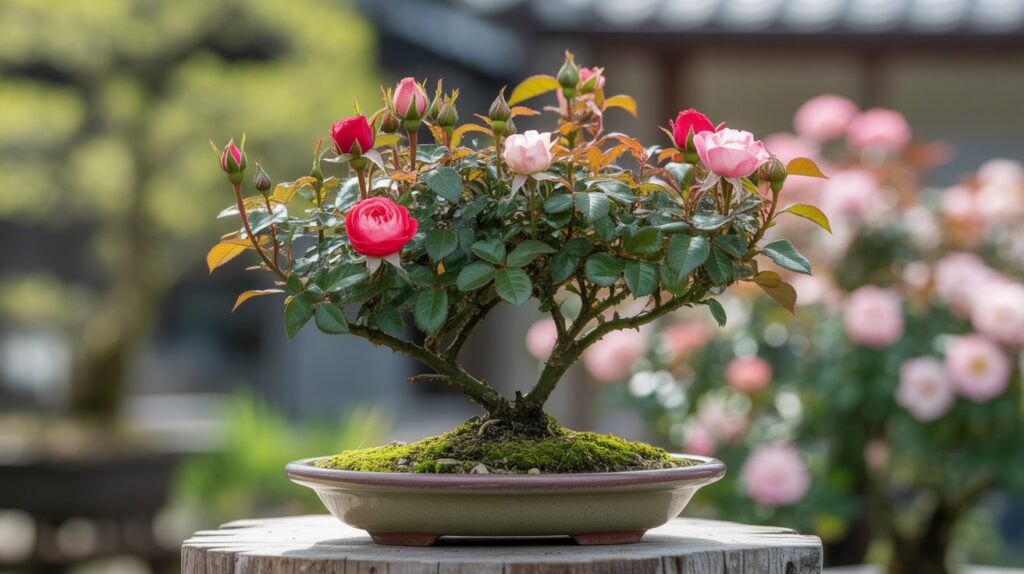
Rose bonsai brings a touch of refined beauty to any space, whether grown indoors on a sunny windowsill or outside on a balcony. With delicate blooms and a compact form, this tiny tree is a great choice for both seasoned growers and newcomers. To keep your bonsai rose vibrant and continually flowering, you should learn a few simple care routines.
In this guide, we’ll cover everything you need from the moment you choose your rose. You’ll learn how to select the best variety for your space, care for it with the right watering, pruning, and repotting schedules, and know when to fertilize. We’ll also feature different types, like the charming miniature rose, the fragrant Chinese variety, and the stunning desert rose, describing how each prefers to be tended.

What is a Rose Bonsai?
A rose bonsai is a tiny rose bush that has been carefully pruned and trained to grow like a miniature tree. With the same gorgeous blooms as full-sized varieties, but on a petite scale, these bonsai treasures fit right onto a coffee table or a garden wall. Combining the colorful rose and the art of bonsai, these plants make beautiful living decorations.
A rose bonsai is basically a tiny rose bush that gets gentle grooming to keep it small but still stunning. By blending the classic rose with bonsai style, this little beauty is perfect for anyone who wants a splash of color but doesn’t have a big yard. Trim the branches and roots just right, and soon you’ll have a rose that only takes up a coffee-cup size of space yet still bursts with fragrance and stunning petals. They fit easily on a patio, a balcony, or even a sunny kitchen counter.
You’ll find lots of rose bonsai options, like tiny mini roses, fiery mini red roses, and, believe it or not, even a desert rose with exotic, plump leaves and flowers. Each type grows tiny flowers, but the colors and leaf shapes can look really different. If you only have a bit of sunny shelf space and you don’t want to fuss over them, the desert rose is a super-tough pick that loves dry air and doesn’t need a lot of fussing.
How to Make Rose Bonsai
To start your own mini rose, take a healthy cutting of an existing rose and pop it into a shallow bonsai pot. Give it little haircuts every few weeks, keep it in a sunny spot, and feed it tiny doses of fertilizer every month. Water just enough so the soil stays lightly moist and watch it grow into the world’s cutest rose bonsai!
To create a rose bonsai, start with a healthy cutting from a larger rose bush. Look for a shoot with a few leaves and a decent length of stem. You can pick from different rose kinds, like mini rose bonsai or Chinese rose bonsai, based on the look you like best.
Once you’ve taken the cutting, put it in a shallow pot filled with fast-draining soil. The pot should be wide enough for the roots but shallow so the tree stays compact. After you’ve potted it, trim the cutting by snipping off extra leaves and stems. This helps the plant put more energy into making roots.
Give the bonsai plenty of light—about 4 to 6 hours of direct sun each day. Water it until the soil is moist, but let it dry out a bit between waterings to keep the roots healthy. You’ll need to trim and shape the tree regularly to keep it small and encourage fresh growth. With a little care, the cutting will grow into a sweet, tiny rose tree, making a lovely decoration or a small, fragrant gift.
Step 1: Select the Right Rose Variety
Choosing the right variety of rose is critical to success. Popular varieties for bonsai cultivation include mini rose bonsai, bonsai rose trees, and Chinese rose bonsais.
Mini rose bonsai: These varieties are typically smaller, making them easier to shape and manage. These plants bloom profusely, making them a favorite choice for bonsai.
Bonsai rose tree: This is a full-sized rose tree that’s carefully pruned and trained to develop a small, elegant appearance.
Chinese rose bonsai: This variety is hardy and adaptable to different environmental conditions, making it a reliable option for beginners.
Always match your bonsai to your space. Desert rose plants love heat, so keep them cozy, while miniature roses kindly adapt to changing temps and love to live indoors.
Step 2: Propagation and Purchase
You have two ways to start: snip a cutting or buy a tiny tree at a garden store. For cuttings, grab a super healthy piece, no bugs, no dried leaves. Chop a section from a strong rose branch that’s got a few leaves. This little stick is your bonsai’s future.
Step 3: Pruning and Shaping
Once your cutting roots or your store plant settles, it’s time to trim. Snip any leaves that touch the pot, then cut the top stem, leaving a few nodes below. This will make the plant send out side branches and start growing a tiny, bushy canopy. Keep snipping any leaves that grow too long to keep the tree-sized shape.
Use bonsai wire to lightly guide the branches where you want them to go. This simple twist will let the plant develop the pretty silhouette you pictured, keeping it neat and tidy. With a little time, the rose will transform into a pocket-sized beauty, still bursting with color.
Step 4: Potting and Transplanting
Every bonsai, even a rose, needs to live in a flat, shallow pot. These containers keep the roots in check, making sure the plant doesn’t outgrow the space. Pick a pot that has room for the roots to spread a little, and trim them back once a year to hold onto that tiny form.
Look for fast-draining soil that’s made just for bonsai. A blend of akadama, pumice, and lava rock keeps the roots damp, but doesn’t let them sit in water, which keeps them happy and healthy.
Step 5: Ongoing Care and Maintenance
With your mini rose in its pot, the journey doesn’t stop. Keep shaping it with little pruning, check for tiny bugs, and check for any wilted leaves. During the growing months, feed it a balanced fertilizer once a month to keep the flowers coming and the leaves fresh.
Watering your rose bonsai is key, but finding the right balance is a must. Overwatering can cause root rot, a serious issue for small plants, while underwatering will dry them out. Check the top inch of the soil: if it feels dry, it’s watering time. Just be sure your pot has drainage holes so the roots don’t sit in a puddle.
How to Grow Rose Bonsai
Start by giving your rose bonsai 4-6 hours of bright, indirect sunlight each day. Water the plant when the top inch of soil feels dry. Use a soil blend that allows excess water to drain away. Prune the plant to shape it, and feed it a fertilizer each month while it’s actively growing. These steps keep the plant healthy and colorful. Here are some extra tips for success:
Choosing the Right Location
Place your desert rose bonsai in a spot that’s warm and dry. It loves bright sunlight and high temperatures, so a sunny windowsill or warm patio is great. If you move it outdoors, pick a sheltered area that is out of strong winds and sudden temperature drops. That extra protection helps the plant avoid shock and encourages healthy growth.
Watering the Rose Bonsai
Watering is the key to happy fresh rose bonsais. These plants enjoy a consistent level of moisture, but soggy roots can lead to rot. Wait until the top inch of soil is dry, then give the plant a thorough soaking until water drains out of the pot. During the active growing season in spring and summer, you’ll water more often. In winter, when the plants rest, cut back and water only when the soil is dry. Always feel the soil before deciding to water to prevent overwatering.
Soil and Fertilization
Healthy soil is a must for a strong desert rose bonsai. Use a fast-draining bonsai mix that allows air to reach the roots. A blend of akadama, pumice, and lava rock works well for these plants. This mixture keeps water from lingering in the pot, giving roots the air and drainage they require. Fertilizer isn’t mentioned here, but usually, a balanced liquid fertilizer at half strength can give your plant the nutrients it needs during the growing season.
Fertilizing your bonsai rose tree lets it soak up the goodness it needs to stay vibrant. During the spring and summer growing months, feed it a balanced bonsai fertilizer every few weeks. When autumn arrives and the tree gears down for winter, ease up and skip feedings until spring returns.
Pruning and Shaping
Pruning keeps your rose bonsai small and sends it into the right shape. Snip off any twig that’s dead, thin, or sickly. To keep the crown tight, pinch today’s summer leaves, and train tomorrow’s new growth by wrapping soft bonsai wire around young branches and guiding them where you want. As you work, picture an airy crown where branches thread light and oxygen in and out; this lowers the chance of diseases and makes new flowers big and happy.
Common Problems with Rose Bonsais and How to Fix Them
Rose bonsais might worry you with signs like soggy soil, tiny insects, or blooms that never happen. Check the tree every week for these signs. If the leaves are pale and the soil is still wet, cut back on the water. Give any hitching pests a gentle wash and boost your tree with good sunlight and that careful pruning. Stick to this simple routine, and your tiny rose tree will keep smiling.
Why is My Rose Bonsai Not Blooming?
When your rose bonsai skips its blooms, it’s usually caused by a few common culprits, including not enough light, cutting back at the wrong time, or a lack of essential nutrients. Fix these issues, and you’re likely to see flowers soon. Here are the main reasons your plant may be holding back on blooms:
- Not Enough Sunlight: Roses need at least 4 to 6 hours of indirect light each day to set buds. Find a bright spot indoors or outdoors that meets this need.
- Too Much Cutting: Pruning while buds are forming can stop flowers before they begin. Trim only after the flowers fade to keep next year’s blooms healthy.
- Missing Nutrients: Roses are heavy feeders. Use a balanced bonsai fertilizer on a regular schedule to give the plant the phosphorus, potassium, and trace elements it craves for flowers.
How to Avoid Overwatering or Underwatering Rose Bonsai?
The weather, the bonsai’s size, and the pot you use help decide its watering schedule. Here’s a simple split for water weight: Before watering, press your finger deep enough that you feel the roots. If the top inch of soil is dry, it’s time to water. If the soil is still wet, wait a few more days. To keep the roots happy, always use a pot that drains well; trapped water can rot roots faster than they can grow. Stick to this routine, and your mini rose is more likely to stay healthy and ready to bloom.
How to Protect Rose Bonsai from Diseases?
To protect rose bonsai from diseases, ensure it’s grown in well-draining soil and avoid overwatering. Regularly inspect for fungal infections and use organic treatments when needed.
Diseases can be a problem for bonsai rose plants, but proper care can help you avoid them. The best way to prevent diseases is by ensuring your bonsai rose tree is grown in well-draining soil and isn’t overwatered. Overwatering can create the perfect conditions for mold, mildew, and root rot. Make sure your plant has proper drainage, and check it regularly for signs of fungal infections like yellowing leaves or a powdery film. If you notice any signs of infection, treat them immediately with organic solutions like neem oil. Regular pruning, proper watering, and ensuring your plant is getting the right nutrients will also help prevent disease.
Conclusion
In conclusion, rose bonsai offers a beautiful blend of the elegance of roses and the art of bonsai. Whether you’re growing a mini rose bonsai indoors or a bonsai rose tree outdoors, the principles of care remain the same: provide adequate sunlight, prune regularly, water carefully, and ensure the plant has proper nutrients. With patience and attention to detail, you can enjoy a bonsai rose that blooms vibrantly and adds a touch of natural beauty to any space.
Follow the tips outlined in this guide to care for your bonsai rose plants, and soon you’ll have a healthy, thriving plant that brings joy with every flower. Be sure to select the right variety for your space, whether it’s the Chinese rose bonsai for its unique look or the hardy desert rose bonsai for low-maintenance care
Common FAQs About Rose Bonsais
How to Make a Rose Bonsai?
Start with a vigorous rose type, like a tiny rose bonsai or a bonsai rose tree. Either take a healthy cutting or buy a young plant. Trim and style it with bonsai wire, and then plant it in a shallow pot filled with fast-draining soil.
How to Grow Rose Bonsai?
Place your bonsai rose tree in sunlight for at least 4 to 6 hours daily. Water it when the top inch of soil is dry, using a light mix that drains well. Prune it often to keep it tiny and thriving, and feed it during the growing months.
What is the Best Type of Rose for Bonsai?
Mini rose bonsai, bonsai rose tree, and Chinese rose bonsai are top picks for this project. These varieties stay small, adapt well, and enjoy growing in bonsai containers. Pick one that matches your local climate and your style.
Why is My Rose Bonsai Not Blooming?
If your bonsai rose isn’t blooming, it may not be getting enough sunlight, or it could be due to improper pruning or a lack of nutrients. Ensure the plant receives sufficient light, prune at the right time, and fertilize regularly for blooming.


